Planning kitchen lighting is very important because the kitchen is a work area that needs to be adequately illuminated. Planning kitchen lighting is to improve safety, work efficiency and comfort, and it can also improve the overall aesthetics of the kitchen.
Safety: Good lighting can improve kitchen safety and reduce the possibility of accidents. Clear lighting can help you clearly see knives, stoves and other dangerous items during cooking, reducing the risk of accidental injuries.
Work efficiency: Adequate lighting can improve work efficiency. When preparing ingredients, cooking and cleaning in the kitchen, clear lighting can help you complete the work faster and increase productivity.
Comfort: Good lighting can improve the comfort of the kitchen. When working in the kitchen, adequate lighting can reduce eye fatigue and make work more comfortable.
Aesthetics: Well-planned lighting can improve the overall aesthetics of the kitchen. It can not only provide practical lighting effects, but also serve as part of the kitchen decoration to increase the overall decorative effect.
What are the kitchen lamps?
Kitchen lamps usually include chandeliers, ceiling lamps, downlights, spotlights, table lamps, etc. These lamps can provide different lighting effects and lighting needs. For example, chandeliers can provide overall lighting, ceiling lamps can provide uniform light, downlights and spotlights can be used for local lighting, and table lamps can provide local fill light. Choosing suitable kitchen lamps can enhance the lighting effect of the kitchen and make the kitchen brighter and more comfortable.
How to choose a chandelier or a ceiling lamp in the kitchen?
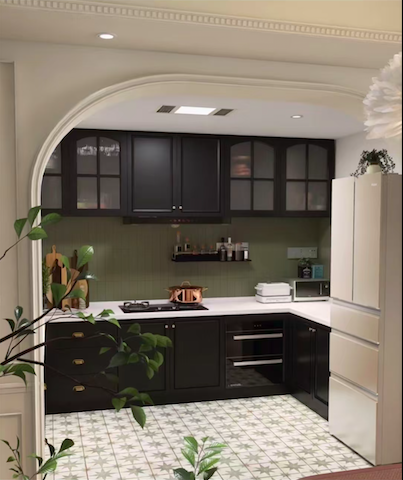
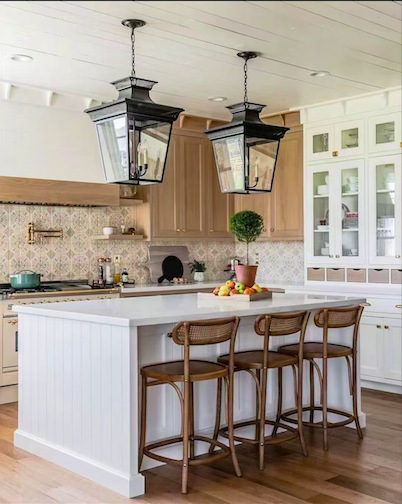
When choosing the main lighting fixtures for the kitchen, you can consider the following points to decide whether to choose a chandelier or a ceiling lamp:
Space height: If the kitchen ceiling is relatively high, you can consider choosing a chandelier because it can be suspended in the air and will not take up too much space, while also providing sufficient lighting.
Style and decoration: Chandeliers are usually more decorative and can be used as decorative highlights in the kitchen to add some personalized elements to the kitchen. If you want the kitchen lighting to have a certain decorative effect, you can choose a chandelier.
Lighting range: Ceiling lamps usually provide a wider lighting range and are suitable for overall lighting. If you want the entire kitchen to be evenly illuminated, you can choose a ceiling lamp.
Cleaning and maintenance: Ceiling lamps are relatively easier to clean and maintain because they are usually installed on the ceiling and are not easy to accumulate dust or smoke.
The final choice depends on personal preference, the actual situation of the kitchen, and the decoration style. If you want the kitchen lighting to have a certain decorative effect, you can choose a chandelier; if you pay more attention to practicality and overall lighting effects, you can choose a ceiling lamp.
How to use local lighting such as downlights and spotlights in the kitchen
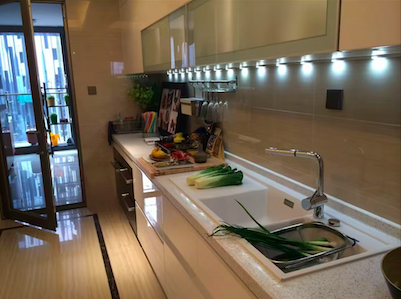
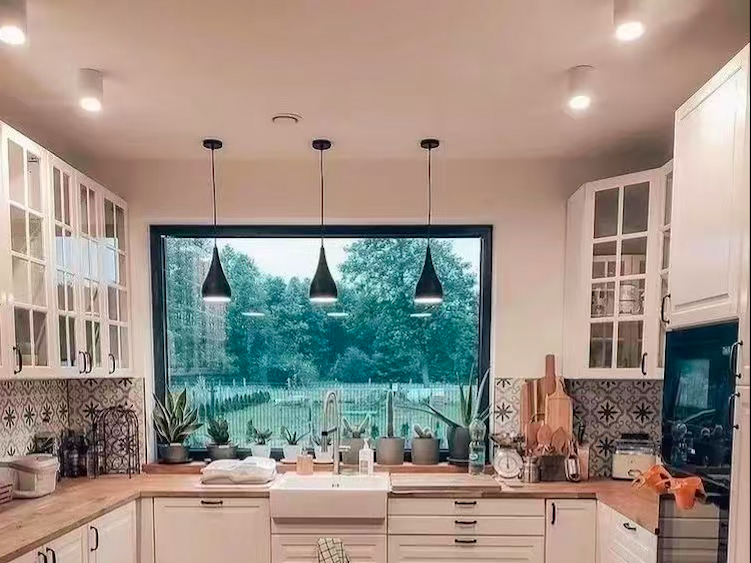
In the kitchen, downlights and spotlights can be used to provide local lighting to help improve work efficiency and cooking experience. Here are some suggestions for using downlights and spotlights:
Kitchen workbench: Install downlights or spotlights above the kitchen workbench or cooking table to provide bright lighting to help clean ingredients, cut vegetables and cook. These lamps should be installed at an appropriate height from the workbench to ensure that the light can cover the entire work area.
Stove area: Install spotlights above or on the side of the stove to provide bright lighting required for cooking. This ensures that pots and ingredients can be clearly seen during the cooking process, improving safety and efficiency.
Sink area: Install downlights or spotlights above the kitchen sink to provide bright lighting required for cleaning and washing. This ensures that cleaning work is more convenient and thorough.
Cabinet lighting: Install downlights inside or under the cabinets to provide lighting inside the cabinets, making it easier to take and put items, especially at night or in dim light conditions.
By properly installing downlights and spotlights, local lighting can be achieved in the kitchen to improve work efficiency and comfort. At the same time, the position and angle of the lamps can be flexibly adjusted according to actual needs and kitchen layout to obtain the best lighting effect.
Is it necessary to use table lamps for supplementary lighting in the kitchen?
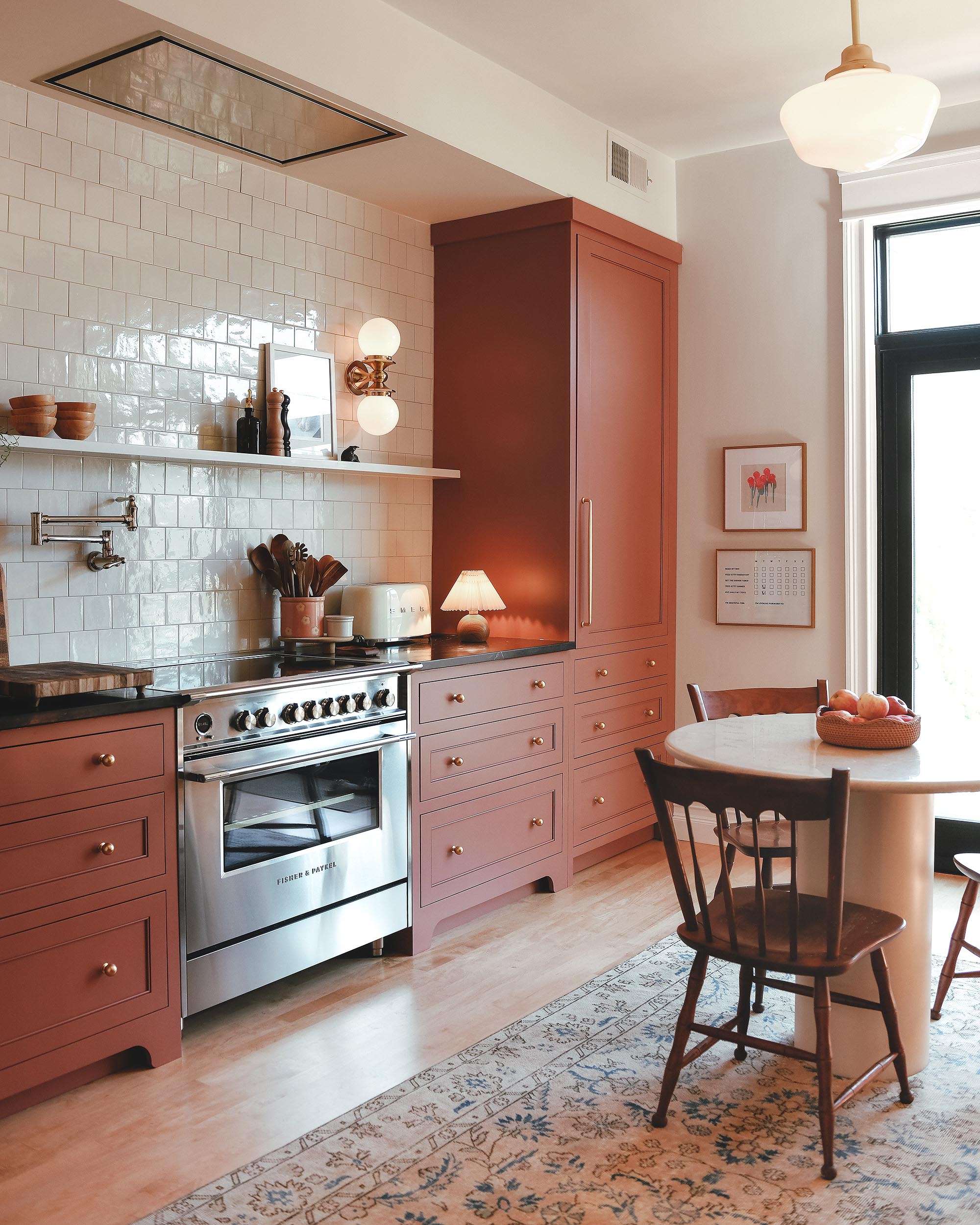
It is usually uncommon to use table lamps for supplementary lighting in the kitchen, because the kitchen usually requires stronger overall lighting to ensure a safe and convenient cooking environment. However, sometimes you can also consider using some table lamps to provide local supplementary lighting in the kitchen, depending on personal needs and the layout of the kitchen.
The following are some situations where you may need to use table lamps for supplementary lighting in the kitchen:
There is a small dining area in the kitchen, and some soft lighting may be needed to create a warm atmosphere. At this time, you can consider placing a table lamp on the dining table.
If there is a large central island in the kitchen, you may do some simple work or read recipes on the island. At this time, you can consider placing a table lamp on the island to provide local supplementary lighting.
In general, it is not necessary to use table lamps for supplementary lighting in the kitchen, but in specific cases, if you need to provide soft lighting or supplementary lighting in a specific area, you can consider using table lamps.
What to pay attention to in kitchen lighting
When choosing and installing kitchen lighting, you need to pay attention to the following points:
Brightness and color temperature: The kitchen needs bright enough lighting to ensure a safe and convenient cooking environment. Choose lamps with moderate brightness and pay attention to color temperature. Generally speaking, warmer lights are more suitable for kitchen environments.
Waterproof and oil-proof: The kitchen is an environment that is easy to get oily and humid, so it is very important to choose waterproof and oil-proof lamps to ensure the safety and durability of the lamps.
Lighting range: Consider the layout and functional areas of the kitchen, and choose the appropriate type and location of lamps to ensure that all areas are fully illuminated.
Easy to clean: Choose easy-to-clean lamp surface materials so that the brightness and light transmittance of the lamps can be cleaned regularly and maintained.
Energy efficiency: Consider choosing LED lamps or other energy-efficient lamps to reduce energy consumption and save energy costs.
In summary, choosing lamps with suitable brightness, color temperature, waterproof and oil-proof, lighting range, easy cleaning and energy efficiency are important factors that need to be paid attention to in kitchen lighting.
When designing kitchen lighting, you can consider the following aspects:
Main lighting: Use ceiling lights or chandeliers as the main lighting source to ensure that the entire kitchen is bright enough. You can choose higher-power lamps to ensure that the entire kitchen can be illuminated.
Task lighting: Install some downlights or spotlights in work areas such as kitchen workbenches, stoves and sinks to provide local bright lighting for cooking and cleaning.
Dining table lighting: If the kitchen has a dining table or breakfast bar, you can install table lamps or chandeliers in these areas to create a warm dining atmosphere.
Cabinet lighting: Install some cabinet lights under the cabinets to provide lighting inside the cabinets for easy access to items.
Consider natural light: If conditions permit, natural light can be introduced through windows or skylights. Natural light can provide soft lighting effects and is also conducive to energy saving.
Consider smart lighting: Consider using smart lighting systems to adjust the brightness and color temperature of the light to meet the lighting needs at different times and scenes.
Taking all the above factors into consideration, a well-designed kitchen lighting solution can improve the comfort and practicality of the kitchen, making cooking and dining more pleasant and convenient.
As a professional indoor lighting supplier, wonled lighting provides a variety of lighting customization and wholesale for kitchen.

